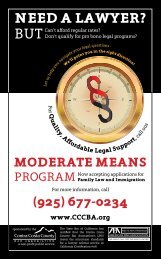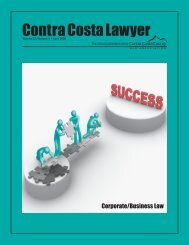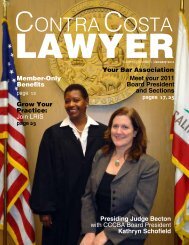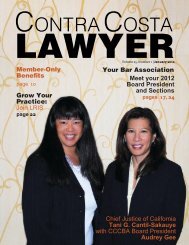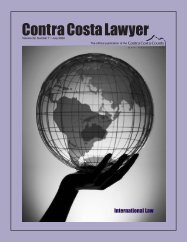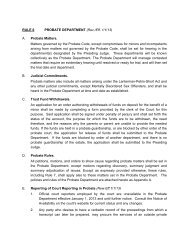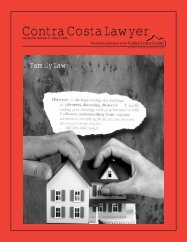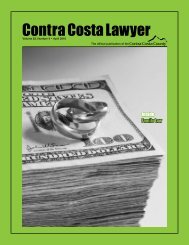Alternative Dispute Resolution Issue - Contra Costa County Bar ...
Alternative Dispute Resolution Issue - Contra Costa County Bar ...
Alternative Dispute Resolution Issue - Contra Costa County Bar ...
Create successful ePaper yourself
Turn your PDF publications into a flip-book with our unique Google optimized e-Paper software.
<strong>Contra</strong> <strong>Costa</strong> Family Law ADRWe’ve Come a Long Wayby Faith JansenFamily Law AltERNAtive <strong>Dispute</strong><strong>Resolution</strong> in <strong>Contra</strong> <strong>Costa</strong> traces itsroots back to the late 1970s when then superiorcourt Judge Donald King (later to becomeappellate justice) spear-headed the publicationof Uniform Guidelines for the administrationof the newly established nine Bay Area countyFamily Court Services offices. These UniformGuidelines completed the shift in judicialpolicy from mandatory “conciliation counseling”(an attempt to reconcile divorcing parties)to child custody mediation (focusing on keepingkids off the witness stand). Most FamilyCourt Services mediators were mental healthprofessionals. Those who had J.D. degrees werenot considered to be practicing law when theymediated custody agreements for the court.As the Family Court Services systemlegitimized the use of mediation in the narrowarea of child custody, private family lawpractitioners saw the potential for usingmediation to settle an entire divorce case. Atfirst, the State <strong>Bar</strong> was resistant to the notionof attorneys practicing mediation, lookingupon it as improper dual representation withconflict of interest problems. Trail blazingfamily law practitioners in the Bay Area foundcreative ways to push forward nonetheless.One tactic they developed to practicemediation and circumvent State <strong>Bar</strong> disapprovalwas to obtain a marriage counselinglicense alongside the legal license. Otherintrepid attorney-mediators plowed forward,expecting the State <strong>Bar</strong> to eventually give upits resistance to change. In the 1980s, therewere ambiguities concerning the professionalliability insurance industry’s coverage ofmediation, again based on the notion thatmediation was improper dual representation.Around the mid 1990s, when theseambiguities were fully resolved in favor ofallowing and insuring the practice of mediationby attorneys, interest in mediationsurged. Civil mediators joined the movementalong with family lawyers.Family law and civil mediation methodshave developed along different tracks. Infamily law mediation, it is common for theparties to attend mediation sessions as unrepresentedparties (pro pers). In this model, eachparty consults with his or her own legal counselbetween mediation sessions, if at all. Incontrast, the attorneys in a civil mediationusually accompany their clients to all mediationsessions. Family law mediation sessions usuallylast two hours and are set weekly or biweekly,proceeding at a steady pace but without pressure.Civil mediation sessions generally arescheduled for an entire day, with the goal ofnegotiating, drafting, and executing a settlementstipulation in one marathon session. Infamily law mediation, the technique of caucusing(separating the parties into different rooms,with the mediator shuttling between them) isgenerally avoided because each self-representedparty may fear that the mediator has lostneutrality and is aligning more with one partythan the other behind closed doors. In civilmediation, caucusing is a standard, highlyeffective technique because the parties havetheir attorneys at their sides at all times.One distinctive aspect of family lawmediation is the need to screen the case at theoutset for domestic violence, psychologicalcontrol, or other power imbalance problemsthat may render it unsuitable for mediation.CCCBA’s Family Law Section has presented aprogram with specific forms and interviewmethods to address this concern. No other areaof mediation requires the legal practitioner tolearn as much about human psychology in orderto understand the personal dynamics influencingthe mental functioning of the parties.In the family law arena, the clients’ emotionaldynamics are highly likely to contaminate theprofessional relationship between the lawyers.Perhaps for this reason, family law practitionershave been and continue to be interested infinding ADR methods that reduce the psychologicaldamage to clients and their children.The latest ADR method to emerge infamily law private practice is CollaborativeLaw. Collaborative Law began in the mid1990s as a hybrid of mediation and traditionalout-of-court four-way settlement meetings.As in traditional representation, collaborativeattorneys provide legal counsel to their client,but they also have an obligation to work withtheir client, the other spouse, and the othercollaborative attorney toward a settlementthat benefits all members of the family. InCollaborative Law, as in mediation, theattorney may not later switch roles andbecome a litigator in the case. As CollaborativeLaw has developed, a team negotiationmodel known as Collaborative Divorce hasemerged in which the parties are paired notonly with collabor a tive attorneys but alsowith mental health professionals (called communication“coaches”) who provide psychologicalsupport for their respective clients andwork with the collaborative attorneys toprevent the negotiation process from beingderailed by emotional issues. Child developmentspecialists and financial specialists arealso brought into this team as neutral consultants.This ADR method utilizes many ofthe same professionals that would appear ina trial but delivers their services within anon-adversarial, confidential framework.Focusing on the development of familylaw ADR at the courthouse, an excitingdevelopment in the last decade has been theaddition of the Family Law Facilitator’s office.This arm of the court staff was created toprimarily assist self-represented child supportlitigants to take some of the load off of theDepartment of Child Support Services. Everyday these attorneys, known as the Family LawFacilitators, work face to face with dozens ofself-represented litigants, utilizing bothfacilitative and evaluative mediation skills.The ADR techniques that work best for thesefacilitators, and the extent to which thesemethods are well received by the public and u6 November 2009



